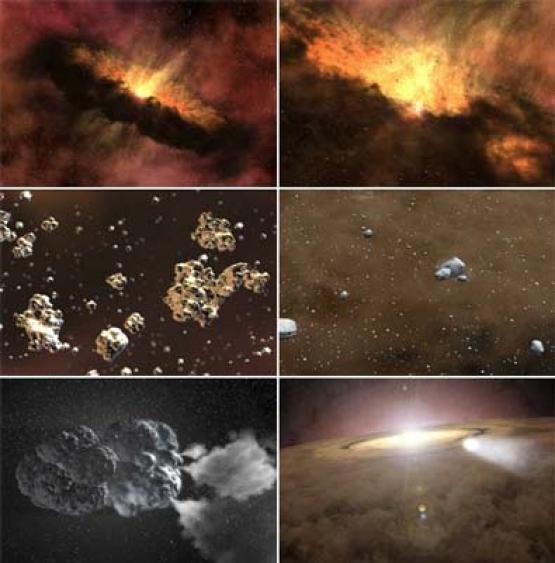|  bisher 441 mal gesehen bisher 441 mal gesehen | | ZurĂĽck zum Bericht | alle Bilder dieser Serie | alle Bilder dieses Autors |  Foto Foto | Foto 4 von 14 | Foto  |  | This artist's animation depicts one of the most widely accepted theories pertaining to the origin of comets.
The simulation opens with a protoplanetary disk, which will eventually turn into a solar system. The fiery yellow ball in the center represents a star like our Sun.
Like a raindrop forming in a cloud, a star forms in a diffuse gas cloud in deep space. As the star grows, its gravitational pull draws in dust and gas from the surrounding molecular cloud to form a swirling disk called a "protoplanetary disk." This disk eventually further consolidates to form planets, moons, asteroids and comets.
As the animation zooms into the disk, micron-size particles of dust can be seen sticking together to form centimeter- and millimeter-sized rocks. As the rocks become more massive, gravity takes over, forcing other surrounding pebbles and dust particles to collide with the larger rocks. The process continues until a comet is born.
Since comets form far from their star in the icy regions of the planetary system, molecules, such as water, carbon dioxide and methane, freeze onto the micron-sized dust particles and rocks before they collide to form a comet.
Once a solar system is formed, the gravitational pull from large planets manipulates a comet's orbit and brings it into the inner solar system. As the comet approaches its star, sunlight warms and transforms the frozen gas on and just below the comet's surface directly into vapor, effectively bypassing the liquid phase. This process is called sublimation.
Sublimation of the molecules beneath the surface forces streams of gas and dust to jet out of the comet, creating an aura or "coma" around the rock. Interactions between ingredients in the coma with surrounding sunlight and solar winds eventually create the comet's tail, pictured here at the end of the animation.
This movie is courtesy of NASA's Spitzer Science Center at the California Institute of Technology, Pasadena, Calif.
Image credit: NASA/JPL-Caltech
|
|

| | Aktueller Bericht: Deep Impact, Tempel 1 Photos / Bilder | | Autor des Berichts: Andi Karr | | erstellt: 04.07.2005 | | bisher gesehen: 441 mal | | Stichworte: Raumfahrt, Deep Impact, Tempel 1, Komet, Photos |
|
|